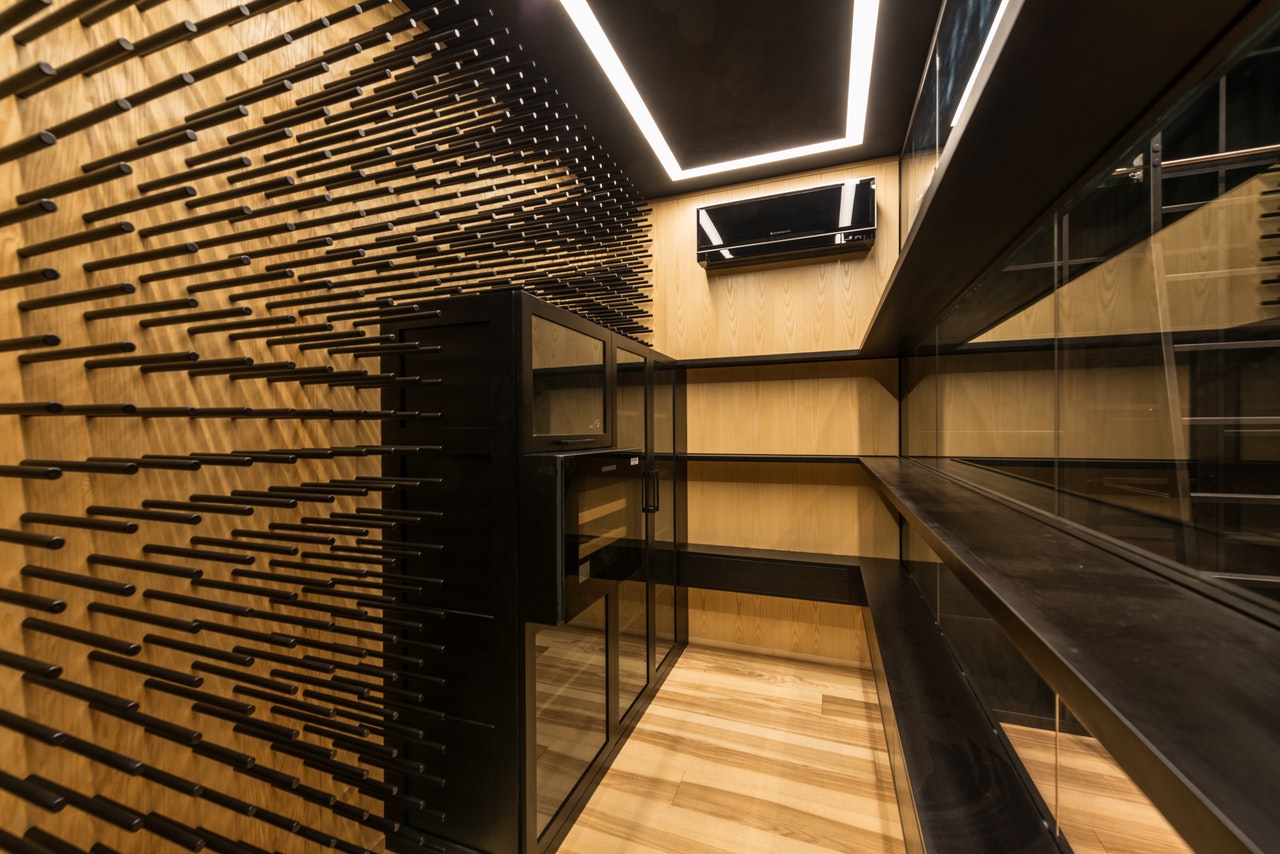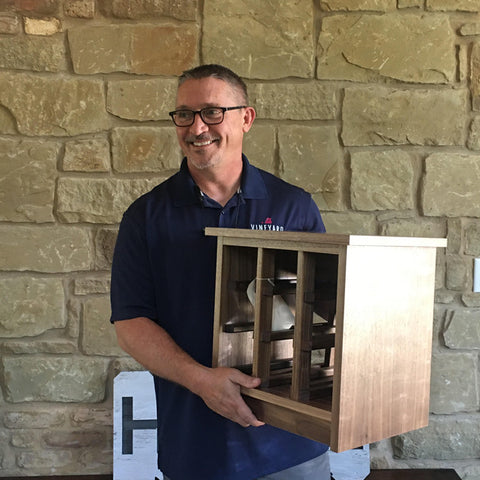Are you in the market for a cooling unit for your wine cellar, but not sure which one to choose? Because there are so many options available, it’s easy to get overwhelmed.
In this post, we’ll make it easier for you to pick the right cooling unit for your cellar. Let’s get started.
Do You Need a Special Cooling Unit for Your Wine Cellar?
First thing’s first, you may be wondering if a cooling unit is even necessary for your wine cellar. Can you use the same AC that cools your house to cool your cellar?
To keep your cellar at an ideal temperature year-round, you need an independent cooling unit. This unit works exclusively in your cellar to maintain a consistent temperature and humidity level. (The ideal temperature for a wine cellar is 55°F and the perfect humidity is between 50 to 70%.) You cannot use your home’s HVAC to maintain this consistent temperature 24 hours a day, 365 days a year. That’s why you need to invest in a wine cooling system for your cellar.
The 3 Types of Wine Cooling Systems
You’re not stuck with one option when it comes to cooling your cellar. There are three main types of cooling systems to accommodate your cellar needs. Let’s review each type:
1) Non-Ducted, Self-Contained Cooling System

Learn more about the CellarPro 1800XT Cooling Unit (up to 250 cubic feet)
The first type of wine cooling system we’ll review is the non-ducted system. This is also known as the through the wall system.
Non-ducted systems work similarly to window AC units. But instead of installing this unit in a window, you cut a hole in your wine cellar’s wall for the unit to fit into. Because everything operates from that singular system in your wall, there are no other vents in your cellar, like you’d see with a ducted system.
Through the wall systems are mounted on the wall. Cool air comes out of one side of the unit (the one facing the cellar) and hot air emits out of the other side. For this reason, you must carefully consider where you’ll mount the unit so that it can exhaust efficiently. They vent heat and must be mounted into a well-ventilated space (on the other side of your cellar) that can handle the excess heat from this unit. This room should be kept to temperatures of 80°F or below to handle exhaust correctly.
If you don’t want the through the wall unit to be vented into an interior room in your house, you may choose a system that vents outside. But it’s important to consider your climate. Through the wall units that can vent outside can work in degrees up to 105°F. If your temperature exceeds that, it may be better to go with an indoor exhaust option or a different cooling system type altogether.
Another key consideration about through the wall units is noise. Because the entire unit is self-contained in one space, it will create noise, especially in the room in which it exhausts into.
Also note that if you ever need to repair a through the wall cooling unit, you’ll need to remove their entire unit and ship it for service. This puts you in a bind if you already have bottles in your cellar when the unit breaks down. You’ll need to either find a way to cool your cellar in the interim or carefully transport your bottles to a short-term storage facility. The latter is not ideal because vibrating your bottles can permanently alter the taste of your wine. So, if you plan to age your wines for a long time, this may be not the best option for your cellar.
However, even with all of these considerations, the through the wall system is an excellent choice for many wine cellars. It’s affordable, efficient, and perfect for homeowners who plan to rotate their collection frequently but want to keep their cellar construction costs low.
Check out our catalog of through the wall wine cooling systems here.
2) Ducted Cooling System

Learn more about the WhisperKOOL Fully Ducted Extreme 3500tiR Wine Cellar Cooler
If you have the budget to pay more, consider opting for a ducted cooling system. These are more capable than non-ducted systems. They’re easy to install, and great for cellars for all sizes, especially larger systems.
There are actually two types of ducted cooling systems.
The first is a ducted self-contained system. This system is fully ducted from both the evaporator and condenser components.
The second type is the ducted split system. This system has separated condenser and evaporator units that are connected by a line set. They work like traditional HVAC systems with part of the unit inside of the home and the other part outside of the home (although some units can sit in a different part of the house).
Both of these systems are connected by ducts that carry the cooled air into the wine cellar. The cooled air is then released into the cellar through a vent.
Unlike a through the wall unit, there is no equipment inside of the cellar.
Check out our ducted wine cellar cooling units here.
3) Split

Learn more about the CellarPro Mini Split 3000S Split System Cooling Unit (up to 600 cubic feet)
In a split system, there are two components: An evaporator unit and a remote condensing unit.
As mentioned above, split systems can be ductless or ducted. In a ductless set up, the evaporator unit is mounted on the wall in the cellar while the condenser is located remotely. This reduces noise and vibration that's harmful to wine from occurring within the cellar.
In a ducted split, both the condenser and the evaporator are located in some place away from the cellar. The cool air travels into the cellar through ducts while the warm air travels away from the cellar via ducts. Ducted split systems are noise-free, but they tend to be the most expensive type of cooling system.
Learn more about split wine cellar cooling systems here.
The Pros and Cons of Each Wine Cooling System
Let’s break down the top pros and cons for each wine cooling system.
Non-Ducted, Self-Contained Cooling System
Price Range: Starting at $1,200
Pros of Non-Ducted, Self-Contained Cooling System
- Affordable
- Easy to install as a DIYer, and you do not need to hire a licensed HVAC/R installer
- Convenient unit if converting a space to a cellar after it's already been built
- These units have built in temperature and humidity control
Cons of Non-Ducted, Self-Contained Cooling System
- Noisy
- Obtrusive because the units stick out of the wall
- When in need of repair, the entire unit will need to be removed from the wall and shipped
- Not ideal for larger cellars
Ducted Cooling System
Price Range: Starting at $1,995
Pros of Ducted Cooling System
- Whisper quiet
- Capable of cooling cellars of all sizes
- The unit is hidden—when inside the cellar, you only see a vent and return
- Less vibrations than a through the wall unit
Cons of Ducted Cooling System
- Expensive
- Requires an HVAC professional to install
- More complicated install that requires ducts to go within the walls of your home
Split
Price Range: From $2,200
Pros of Split
- Affordable (for larger cellars)
- Quieter than self-contained, through the wall systems
- Can be serviced on site without having to ship the entire system
Cons of Ductless Split
- Louder than a ducted system
- Can be expensive for smaller cellars
- Some units don’t control humidity (may be required to upgrade for this option)
- Requires installation from an HVAC professional
What are the Best Cooling Unit Brands?
Here are our top selling brands for wine cellar cooling units:
Final Thoughts
Which cooling unit should you choose for your wine cellar? It depends on several factors, such as the size of your space, the location of your cellar, and how much you’d like to spend. It’s also important to know the thermal load of your wine cellar. This determines how much energy you need to cool the cellar to a specific, ideal temperature within 60 minutes. Calculating your cellar’s thermal load can be complicated, but we’d love to help.
If you have any questions about your thermal load or how to determine the right type and size cooling unit for your space, let us know. Helping you build the best wine cellar is our top priority. Click here to contact us now through phone, email, or chat.



2 comments
Great article! Finding the right cooling unit for a wine cellar can be challenging, but your tips make it so much easier. I love how you emphasized factors like size, insulation, and humidity control. This is a must-read for anyone looking to preserve their wine collection perfectly.
Great info! Thanks for sharing such information with us.